Pigeon Populations : 30% Decline In Urban Areas Across US Cities
Pigeons are frequently viewed as an inevitable fixture in metropolitan environments and have long been an intriguing and overlooked component of urban ecosystems.
These adaptable birds have thrived in cities for centuries, earning them the colloquial moniker “city pigeons” or “urban doves.”
Their resilience to human activities and ability to coexist with urban environments have made them a symbol of familiarity in the concrete jungles of the United States.
However, in recent years, reports from across the nation suggest a disconcerting trend – a shocking decline in urban pigeon populations. The common feral and rock pigeon population in the US has declined by 46% since 1966.
This decline in pigeon populations is alarming, as these birds play essential roles in urban ecosystems, contributing to biodiversity, seed dispersal, and nutrient cycling.
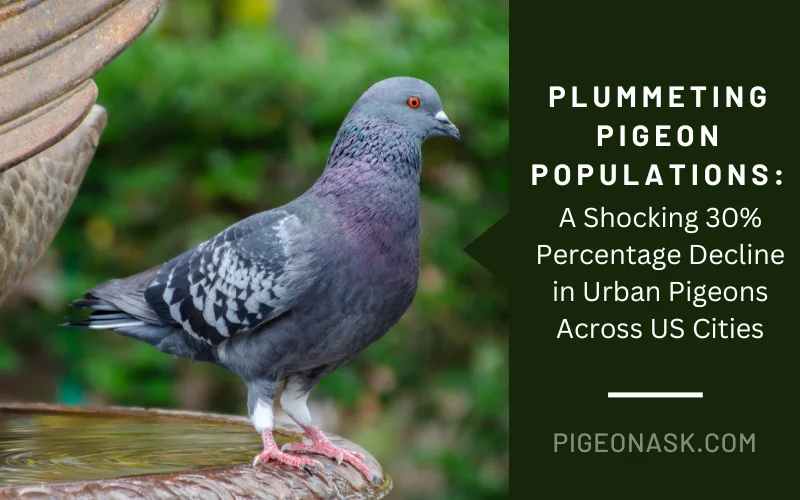
Furthermore, they serve as urban wildlife ambassadors, connecting people to nature and sparking curiosity about the natural world.
While scientific attention has been predominantly directed towards endangered and charismatic species, urban pigeons have been slightly understudied. Leaving a significant gap in our understanding of their ecology and the factors driving their decline.
To address this knowledge deficit, this study investigates the extent and underlying causes of the dramatic decline in urban pigeon populations across US cities.
Through rigorous data collection and analysis, we hope to provide critical insights that inform conservation efforts and urban planning strategies to safeguard the future of these often-overlooked urban residents.
Want to learn more about pigeon:
What Are the Causes of the Declining Pigeon Population in US Cities?
Pigeon populations in many U.S. cities have been experiencing a significant decline. Not only pigeons, nearly 3 billion of the total bird population declined since 1970 in North America.
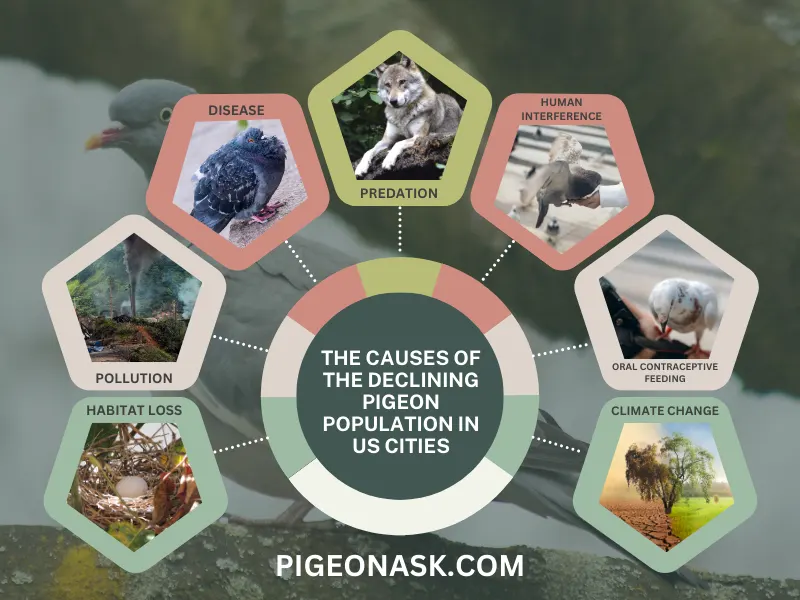
Which has raised concern among scientists, environmentalists, and wildlife lovers.
Various factors are believed to contribute to this decline, including habitat loss, pollution, disease, predation, and human interference.
Habitat Loss
The rampant urbanization and infrastructure development in major cities often destroy the natural habitats of pigeons, leaving them with fewer areas to nest and forage for food.
Nests are often located in buildings’ crevices, ledges, and under bridges. However, with modern construction trends, these spaces are becoming scarce.
Pollution
The adverse effects of pollution on wildlife cannot be overemphasized. Air and water pollution, including chemical emissions from factories and vehicles, can harm pigeons’ respiratory systems and contaminate their food and water sources.
Disease
Disease outbreaks, like avian influenza, parasite infestations, or bacterial infections, can significantly decline pigeon populations. The crowded living conditions of urban environments can accelerate the spread of diseases amongst these birds.
Predation
In urban areas, pigeons confront many predators, such as hawks, falcons, cats, dogs, raccoons, ferrets, etc. These predators have a significant impact on pigeon populations, especially on the more vulnerable chicks.
According to a report by The New York Times, more than 300 pigeons are killed every week by falcons citywide.
Human Interference
Pigeon numbers are diminishing as a result of human activity. This includes intentional killing or trapping of pigeons, considering them pests in urban areas.
In addition, food sources available to pigeons in city environments, such as bread crumbs and other leftovers, are often not nutritionally adequate and can negatively impact their health and reproduction.
Oral Contraceptive Feeding
The declining pigeon population across the United States and worldwide is a concerning ecological issue linked to oral contraceptives. This unexpected connection highlights human activities’ complex and often unintended consequences on the environment.
Oral Contraceptive Feeding involves providing pigeons with food that contains contraceptive agents designed explicitly for avian species. This method is not lethal and does not cause any adverse effects on the birds’ health.
However, using this method significantly dropped pigeons and other bird populations worldwide.
Climate Change
Climate change critically threatens urban wildlife, with the pigeon population in US cities seeing a significant decline due to various factors linked to changing weather patterns.
Rising temperatures, more frequent extreme weather events, and disruptions to natural biomes make survival more challenging for pigeons, affecting their ability to find sufficient food and shelter and increasing their vulnerability to diseases.
Additionally, weather-related disruptions in breeding and migratory patterns contribute to the decline in numbers. Without significant advancements in climate change mitigation at a global scale, the urban pigeon population, among other forms of wildlife, continues to be at risk.
Impact and Implications of Plummeting Pigeon Populations
The occurrence of significant pigeon population declines across numerous U.S. cities carries various ecological, economic, and social implications.
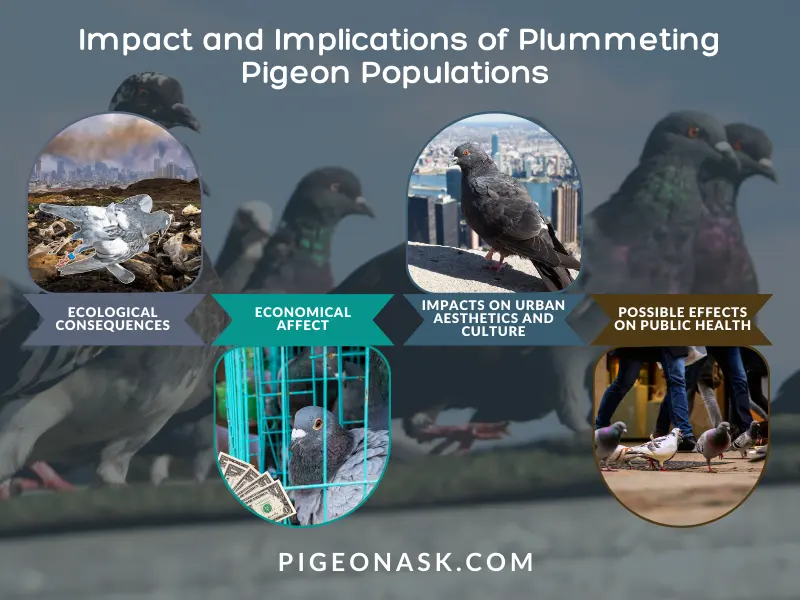
A Scientific Reports study reveals a widespread reduction in their numbers, with a staggering 30% (three-decade) decline reported all over North America.
Ecological Consequences
Ecologically, pigeons and other birds serve as significant contributors to the urban ecosystem.
They play an instrumental role in nutrient cycling, aiding the decomposition process and facilitating plant growth with their droppings (Vincze et al., 2016).
Moreover, they are vital prey for various urban-adapted predators, like falcons, hawks, and foxes, contributing to the stability and diversity of urban food webs (Fuller et al., 2012).
Pigeons, regardless of their common perception as pests, do play an essential role in urban ecosystems.
According to researches such as Haag-Wackernagel (1997) and Sol et al. (2013), pigeons serve as prey to urban predators like hawks, kestrels, and falcons, thereby serving a pivotal role in the food chain.
Diminishing pigeon populations can have cascading effects, further jeopardize these ecological services, and disrupt biodiversity, alienating cities from nature.
Economical Affect
Economically, the city pigeon, otherwise regarded as a pest, can also affect urban maintenance directly and indirectly.
On one hand, fewer pigeons might result in less fouling and associated cleaning expenditures for buildings and public spaces, as suggested in a study by Orros and Fellowes (2015).
However, pigeons also influence urban wildlife tourism, a source of revenue for some cities.
For instance, watching Peregrine falcons (a predator of pigeons) has become popular in cities like Chicago (BirdWatching HQ). Thus, reduced pigeon populations can indirectly affect such economic activities.
Impacts on Urban Aesthetics and Culture
Pigeons have been an integral part of cityscapes across the United States, featuring in popular art, literature, and urban culture.
The pigeons fluttering around public squares, parks, and old buildings contribute to the aesthetic appeal of these places, defining the ambiance of these spaces (Jerolmack, 2008).
Fading pigeon populations may lead to a marked change in urban aesthetics and devoid cities of their familiar and iconic presence.
Possible Effects on Public Health
Pigeons, while often associated with the spread of diseases, also play a somewhat beneficial role in public health.
They consume a substantial amount of food waste present in open and unclean spaces, which if left unattended, can attract rats and other vermin, leading to serious health hazards (De Laet & Summers-Smith, 2007).
Yet, the decline in pigeon population may necessitate further research to understand its potential fallout on urban public health.
Case Studies on the Pigeon Population Decline US Major Cities and Worldwide
Pigeon populations worldwide have witnessed significant decline over the last few years.
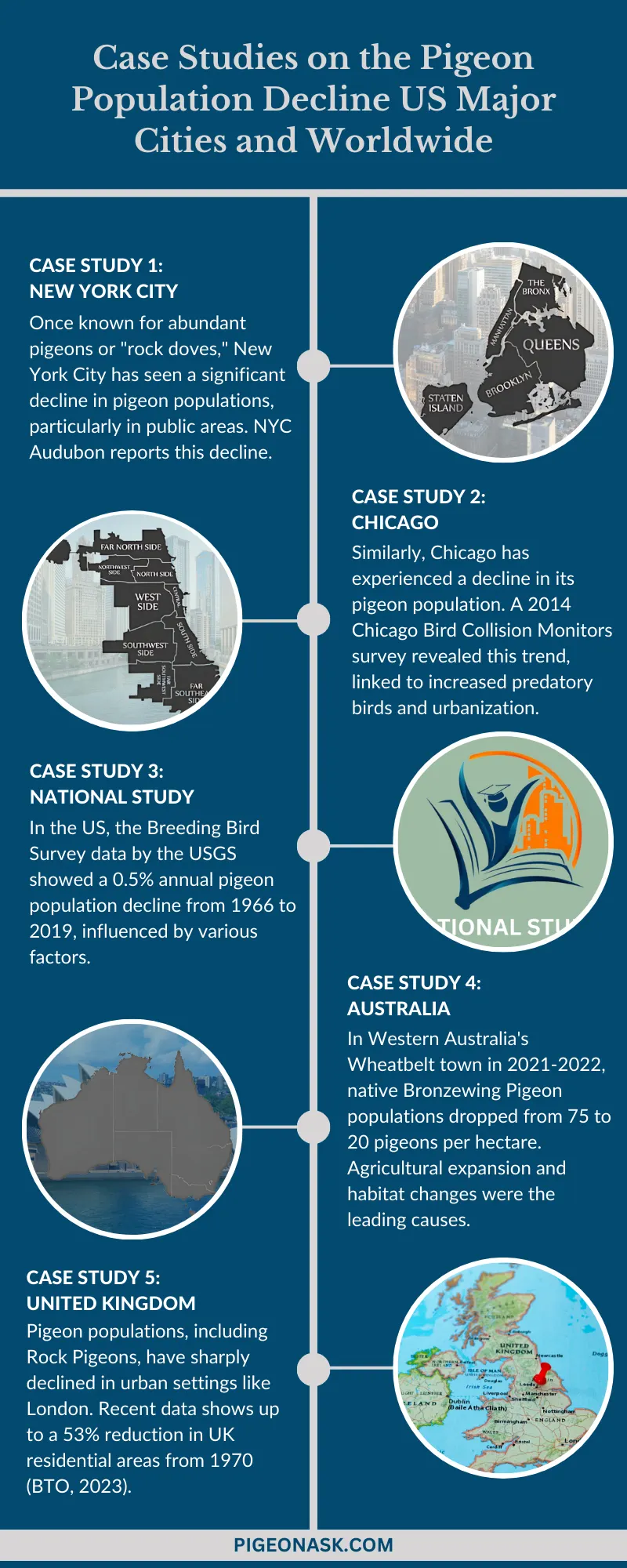
Researchers have undertaken in-depth studies and devised case studies to investigate this peculiar phenomenon, which is believed to be linked to human activities and environmental changes.
Case Study 1: New York City
One of the most iconic symbols of New York City has always been its abundant population of pigeons, also known as “rock doves.” However, recent trends and studies indicate a significant decrease in their numbers.
According to the NYC Audubon, there has been a notable pigeon population decline in the city.
While no specific numbers are provided, the decline is evident in the changes observed in the once pigeon-infested areas such as public parks and squares, where the pigeon population has notably decreased.
Case Study 2: Chicago
Likewise, in Chicago, the effects of pigeon population decline are noticeable. A comprehensive survey conducted in 2014 by the Chicago Bird Collision Monitors indicated that the population of pigeons in the state showed a downward trend.
The reasons attributed to this decline included a rise in predatory birds, habitat destruction, and lack of food supply due to urbanization.
Case Study 3: National Study
On a national scale, The Breeding Bird Survey data collected by the United States Geological Survey (USGS) also showed a decline. Between 1966 and 2019, there was an average population decline of 0.5% per year.
That may seem like a small number, but the implications can be drastic when extrapolated over almost half a century.
The decline may be attributed to several factors, from changes in land use and practices, food source availability, predation, disease, and possibly even climate change.
Case Study 4: Australia
Researchers in a Wheatbelt town (Western Australia, 2021-2022) recorded a significant decline in the native pigeon (Bronzewing Pigeon) population. A substantial fall from 75 pigeons per hectare to merely 20 was noted (DBCA, 2022).
Primary reason attributed to this decline was the increased agricultural activity and habitat disruption.
Case Study 5: United Kingdom
Populations of many species of pigeons, including Rock Pigeons (Columba livia), have seen sharp declines, particularly urban landscapes such as London. In the past decade, there has been a significant downtrend in pigeon population all over Britain (RSPB).
A more recent study by the British Trust for Ornithology (BTO) reported that residential areas in the United Kingdom witnessed up to 53% decrease in pigeon and other birds populations from 1970 to recent days (BTO, 2023).
Rare, Endangered and Extinct Breed of Pigeons
Pigeons are one of the most diverse bird species, with over 300 different breeds around the world.
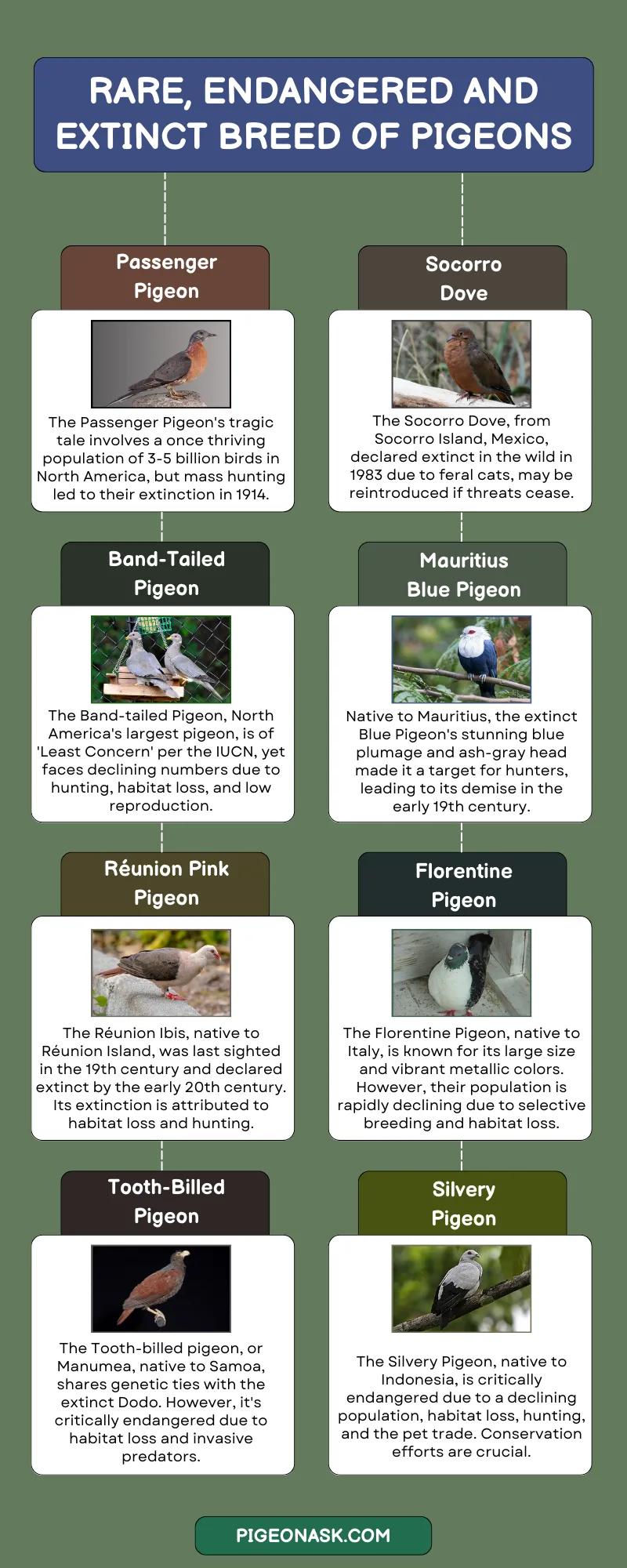
Domesticated for thousands of years, these gentle birds have served various roles, from graceful symbols of peace to efficient, life-saving message carriers in the days of yore.
Despite pigeons’ importance in our lives and nature, many breeds have gone extinct or become extremely rare due to habitat loss, hunting, and human-related activities.
01. The Passenger Pigeon (Ectopistes Migratorius)
Perhaps the most tragic story of pigeon extinction is that of the Passenger Pigeon. These birds were once so abundant in North America that they were believed to account for up to 40% of the total bird population, with an estimated count of three to five billion at their peak.
However, their large population size was one of the reasons for their downfall, being hunted in masses for cheap meat. The last known passenger pigeon, Martha, died in the Cincinnati Zoo on September 1, 1914, marking the extinction of this species.
02. The Socorro Dove (Zenaida Graysoni)
Hailing from Socorro Island, Mexico, this bird was declared extinct in the wild in 1983, largely due to feral cats introduced to its island habitat.
A few dozen Socorro Doves remain in captivity, and efforts are being made to reintroduce them to their native habitat if the threats can be eliminated.
03. Band-Tailed Pigeon (Patagioenas Fasciata)
The Band-tailed Pigeon is a beautiful bird native to the Americas, more specifically present in parts of the United States, Mexico, Central America, and South America. It is the largest pigeon species found in North America.
Featuring a pale gray body and a purplish head, with white crescents above and below its eyes. Its name comes from the broad, bright band towards the tip of its tail.
The Band-Tailed Pigeon is a species of bird that is currently categorized as ‘Least Concern’ according to the International Union for Conservation of Nature (IUCN) Red List of Threatened Species since 2016.
Although it does not yet fall under the categories of threatened or endangered, an alarming decline in the population of this bird species has been observed.
Their numbers are declining on average 2% a year. The major contributors to their declining numbers are hunting, loss of habitat due to deforestation, low reproductive rate and disease.
If these trends continue unalleviated, the Band-Tailed Pigeon may shift towards a more critical IUCN status.
04. Mauritius Blue Pigeon (Alectroenas Nitidissima)
This pigeon was native to Mauritius but was declared extinct in the early 19th century due to excessive hunting and habitat destruction. Its striking blue plumage and ash-gray head supposedly made it a target for hunters.
05. Réunion Pink Pigeon (Nesoenas Duboisi)
This species was native to Réunion Island. It was last sighted and collected in the 19th century and then declared extinct by the early years of the 20th century. Habitat loss and hunting are believed to be significant causes behind its extinction.
06. Florentine Pigeon
Various breeds, albeit with dwindling numbers, are still surviving, such as the Florentine Pigeon, a beautiful bird characterized by its gigantic size and brilliant metallic colors.
These pigeons are native to Italy, but their numbers are decreasing at an unprecedented rate due to selective breeding practices and habitat loss.
07. Tooth-Billed Pigeon (Didunculus Strigirostris)
The Tooth-billed pigeon, or Didunculus strigirostris, is a unique species of pigeon that is endemic to the rainforest of Samoa. It is known by several names, such as the Samoan pigeon, Manumea, or Little Dodo due to its close genetic relationship with the extinct Dodo bird.
Despite its cultural significance, the tooth-billed pigeon is sadly categorized as critically endangered due to habitat destruction and predation by invasive animals. The decreased forest cover and the direct hunting for its meat has made this bird a rare sight.
08. Silvery Pigeon (Columba Argentina)
The Silvery Pigeon is a very rare species of bird in the pigeon family, also known by its scientific name “Columba argentina.”
It is native to Indonesia, particularly to the islands of Sumatra, Nias, and perhaps Batu. This bird species is named because of its unique, silvery-blue and gray plumage.
Silvery Pigeon is classified as Critically Endangered by the International Union for Conservation of Nature (IUCN) due to its exceptionally small population which appears to be declining further.
And the primary threats to these pigeons are habitat loss due to extensive deforestation, hunting, and exotic pet trade.
Preservation efforts are highly important in sustaining and ideally increasing the population of these rare and nearly extinct pigeons. They serve as reminders of the noticeable impact humans have on the natural world, sometimes leading to irreversible consequences such as extinction.
Recommendations and Mitigation Strategies to Save Pigeons in Urban Areas
Urban areas are increasingly becoming inhospitable to various bird species, particularly pigeons. Despite pigeons often being labeled as pests, they play crucial roles in the ecosystem, such as pest control, decomposition, and even acting as keystone species.
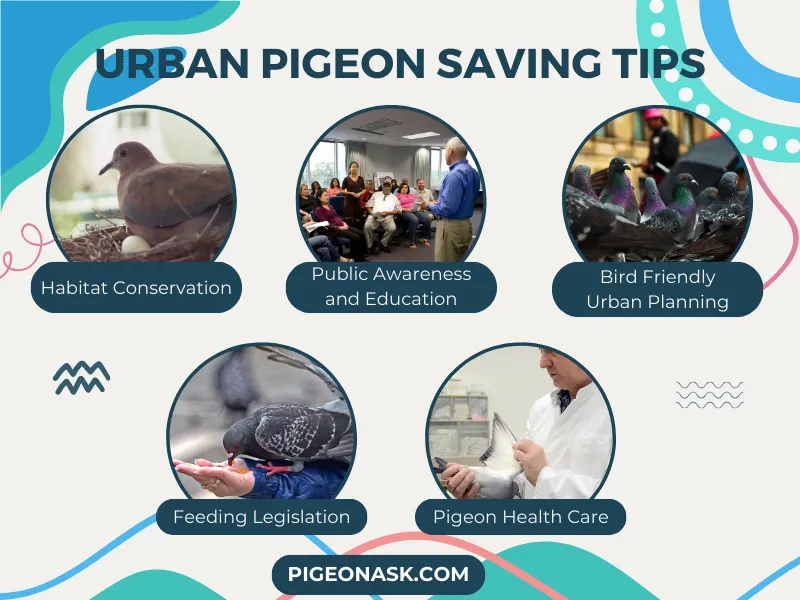
The surge in urbanization coupled with human activities poses serious threats to pigeon survival. Here, we outline some viable recommendations and mitigation strategies to conserve pigeons in urban areas.
Habitat Conservation
According to a study carried out in 2016 by the University of Leicester, UK, pigeons prefer to nest in urban areas with a high density of green spaces, likely due to increased availability of food resources and lower risk of predation.
Initiatives aimed at maintaining and creating green spaces in cities and towns would significantly enhance the survival and reproductive success of urban pigeons.
Public Awareness and Education
Most humans consider pigeons as a nuisance. Fostering compassion and understanding towards pigeons through educational campaigns can help the cause.
In New York City, organizations like the Wild Bird Fund are actively working towards rehabilitating city wildlife and educating the public about the importance of cohabitation.
Bird Friendly Urban Planning
Pigeons frequently collide with buildings, leading to significant fatalities. Integrating bird-safe design elements in new constructions and modifying existing ones would significantly reduce these avoidable deaths.
They include using patterned glass and dimming the lights of high-rise buildings during peak migration periods.
There are many organizations like NYC Audubon and Chicago Bird Collision Monitors in major cities in the US working on bird collision monitoring. They organize public awareness and treatment program and collects data on collision occurrences.
Feeding Legislation
Overfeeding or poorly disposed food waste contributes to the overpopulation of pigeons in city centers. Regulating feeding habits and imposing fines could help maintain a healthy population.
For example, Venice implemented pigeon-feeding restrictions in St. Mark’s Square, resulting in a decrease from over 40,000 birds to an estimated few thousands.
Pigeon Health Care
Diseases such as avian influenza can decimate urban pigeon populations. Collaboration with local veterinary universities and organizations could prompt regular screenings for diseases and appropriate interventions.
Final Remarks
The steep decline in urban pigeon populations in the United States is a grave matter that needs urgent attention. Prompt action and intervention to address the root causes are needed to sustain the pigeon habitat and uphold urban biodiversity.
It is clear that pigeon populations in these areas are not just slowly decreasing; they are plummeting at a rate that could significantly disrupt the urban ecosystems.
There is conclusive evidence to suggest that the reasons for this decline are multifaceted, involving elements like changes in urban design, threats from predators, lack of nutrition, exposure to pollutants, and various disease burdens.
Pigeons, often disregarded as mere city-dwellers, play a remarkable role in these systems. They aid in cleaning the environment by feeding on waste and help maintain a balance in the food chain.
Moreover, the decline in pigeon populations can potentially affect social and cultural aspects of city life. Pigeons have been a synonymous presence in urban landscapes, and their decline could profoundly change the socio-cultural fabric of urban environments.
Therefore, proactive measures need to be taken to mitigate this alarming decline. City planners and administrators should work together to create urban environments that are more conducive to the survival of pigeons.
Besides regulating the urban design aspects, it is also crucial to address issues related to pollutants and provide adequate nutrition.
Increased efforts towards urban biodiversity conservation will equip cities to support a wide range of species, thereby ensuring the health and well-being of the birds and the ecosystem at large.
References:
- https://www.wsj.com/articles/bird-populations-plummet-in-north-america-11568930443
- https://www.britannica.com/animal/passenger-pigeon
- https://www.worldatlas.com/articles/the-eleven-species-of-pigeons-and-doves-that-are-on-the-brink-of-extinction.html
- https://www.scientificamerican.com/article/3-billion-to-zero-what-happened-to-the-passenger-pigeon/
- https://www.nhm.ac.uk/discover/news/2023/may/britain-has-lost-73-million-birds-over-the-last-50-years.html
